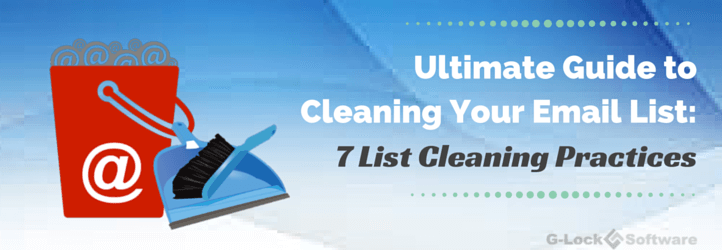Cleaning Your Email List: The Ultimate Guide
Would you like to lower your bounce rate, increase engagement and open rate, and reduce the costs of your marketing campaigns?
I bet, you would!
How do you achieve that?
By cleaning your email list.
But before we dive into list cleaning practices, let's talk about the importance of having a clean mailing list and consequences of sending emails to a "dirty" list.
Why Clean Your Email List
Needless to say, purchasing or harvesting email addresses is a big "no-no."
But even if you're collecting emails by a confirmed opt-in method, your email list still needs to be cleaned.
Even opt-in email lists can become outdated over time and contain abandoned email addresses, addresses of people who are no longer interested in your content, and fake email addresses that people submitted only to get your lead magnet.
It's important to remove all these from your list for several reasons:
Firstly, if subscribers do not wish to receive your mailings anymore, they may report your emails as spam instead of simply unsubscribing from the list. One study showed that about 40% of recipients do it because they can't find the unsubscribe link or don't trust it.
If enough subscribers are sending complaints, your future campaigns will be automatically sent to the junk folders of other recipients who still care of your messages.
But that's not the only reason your emails land in the spam folder. There are other signals of spam such as low open rates and high bounce rates. It means that if a lot of people do not interact with your messages, email providers will consider your campaigns as "spam" and the users who really love what you send won't get your emails.
So, cleaning your email list is the first step to eliminating filtering and blocking problems and reducing your campaigns costs.
Now:
If you are really worried about your email list hygiene or noticed a drop in your open rate over the past time, check the list cleaning practices below that you can apply right now.
7 Tips for Cleaning Your Email List:
1. Remove People Who Didn't Explicitly Opt-In
There are several ways to get people on your list, but the only legal way is to allow users to personally subscribe to your list. It is also the best way to come up with a valid and quality list.
Purchased or scrapped email lists are known to contain invalid addresses and spam traps, which will increase bounce rates and risk of blacklisting problems. Even if the email addresses are valid, those people did not opt-in to your list and are likely to report your emails as spam.
With this said, ask the user's permission through a sign-up form on your website or social media before adding them to your list. And remove addresses you did not collect using a permission-based method.
2. Remove Misspelled Email Addresses
Misspelled email addresses can dramatically increase your bounce rates. That's why it'important that you check and correct obvious misspellings like jonh@gmailcom, mary@outlook.coom, or glenn!yahoo.com.
To protect yourself from misspelled addresses and reduce manual work, set up a confirmed opt-in process on your website which means that users must confirm their subscription by clicking the link in the confirmation email.
The confirmed opt-in process allows eliminating mistyped addresses before they get on your list and avoid malicious email subscriptions.
3. Remove Distribution and Role Email Addresses
Certain email addresses are set up to have a specific function within an organization and are intended only to receive messages related to that function. For example, "abuse@XYZ.com" is the email address a company uses to receive email abuse reports.
Because such accounts are tied to specific functions in a company, they're not intended for personal use such as subscribing to email marketing communications. Aside from being an annoyance, this also raises the likelihood that somebody in the organization will report your messages as spam. That can hurt your email deliverability.
Mailing lists with lots of distribution and role accounts can also make you look like a spammer to blacklist agencies such as Spamhaus. Role account addresses are usually posted on public Web pages and often wind up in master databases, which are rented or sold to email marketers looking to build up their lists faster than they could if they used only permission-based names.
Further, some blacklists deliberately use role addresses as "honeypots" to trap spammers. They claim that any email sent to those addresses is spam by default because the address was obtained and used without permission.
Thus, these types of email addresses should be spotted and removed from your mailing list.
4. Remove Bounce Email Addresses
Bounce messages are a part of email marketing. Sometimes they happen because of problems that are beyond your control, and sometimes they come because something is wrong with your mailing list hygiene, your message or your email process setup.
There are two types of bounce emails: soft bounce and hard bounce.
A soft bounce is an email message that reaches the recipient's mail server but bounces back before it is delivered to the intended recipient.
A soft bounce occurs because of temporary issues such as the recipient's mailbox is full, the server is down or not responding, the message is too large or the message is blocked by spam filters. Most email service providers will attempt to deliver the email for a course of a few days. If it is still undelivered, it becomes a hard bounce.
A hard bounce results from permanent delivery problems such as invalid email addresses and blocking of the sender IP address. Hard bounce addresses are what you have to worry about because they are doing you more harm than good. If Internet service providers see that a lot of addresses are not receiving your emails, they'll filter your campaigns as spam.
Many email service providers deliver data on bounce rates, but sometimes those reports are short and do not give the detailed error description. So, an automated third-party tool for processing bounce emails might be a better solution.
Besides processing bounce emails, you may want to check your email list for invalid addresses BEFORE you start sending email campaigns to it. It makes sense if your opt-in list has not been emailed for 6-9 months and got "cold." You can use a desktop email verifier software like Advanced Email Verifier or online email verification services like BriteVerify, FreshAddress or DataValidation to determine invalid addresses on your list on a proactive basis.
5. Remove Complaining Addresses
Spam complaints may happen even if you have a permission-based email list. Sometimes people click the "Report spam" button because they don't trust the unsubscribe process rather than because they consider your email as spam.
Whatever the reason a complaint happens, you must remove the addresses of complaining users from your list to protect yourself from delivery troubles with ISPs. ISPs see spam reports as a negative factor when evaluating your sender reputation.
The good news is that most ISPs will tell you which recipients reported your message as spam if you sign up for their feedback loop services. You can find links to feedback service signup pages with common ISPs here.
Then:
6. Remove Unsubscribed Users
It's important that you remove the addresses of recipients that have unsubscribed from your list since those people don't want to receive your emails anymore. Thus, make sure your unsubscribe process is working correctly.
You can have an instant unsubscribe process or confirmed unsubscribe process if you wish, but the most important thing is to process unsubscribe requests in a timely manner.
Email service providers and some in-house email systems like EasyMail7 do it automatically for you. But in other cases, you'll have to use a 3rd party tool, for example G-Lock Email Processor, to handle unsubscribe requests.
Handling unsubscribe requests with EasyMail7
7. Remove Inactive Subscribers
Recipient engagement is another metric watched by ISPs when measuring the sender reputation. If a lot of users are not engaging in your campaigns (they are not opening, not replying, not moving the emails anywhere), your sender reputation goes down.
When it comes to mailing lists, quality beats quantity. Instead of trying to blast your campaigns out to as many users as possible, focus on active and engaged subscribers on your list.
Check your email tracking reports and notice the last date the user opened your email. There's no sense of sending emails to people who haven't interacted in years; they're not opening your emails anyway.
But before you remove inactive users from your list, consider sending them a re-engagement campaign first. You may try enticing them with an incentive, such as a gift or discount. If the majority of users on your list are inactive, it may be worth re-working your entire marketing strategies and deliver content that meets the subscriber's expectations.
After you used all the possibilities to re-engage inactive users but they still haven't responded, as part of email list cleaning process remove those people from your main list and stop sending emails to them.
You'll want to simply separate inactive recipients from your active audience but never delete email subscribers from your base. You can always use those emails for further retargeting people via Facebook or Google Adwords.
As you see, maintaining a clean and active email list is the prerequisite for keeping your email messages out of the spam folder, avoiding blocking issues, reducing your costs and increasing ROI.
Thus, if you are concerned your list quality, start with the above tips for cleaning your email list right now.

Get G-Lock Email Verifier for Free Today!
If you are getting too many bounce and undeliverable emails and being blocked as a result, G-Lock Email Verifier can help you clean your list from bad email addresses and invalid domains and increase your e-mail campaign performance by focusing only on REAL prospects… No Monthly Fees!
This software is a must have in your emailing arsenal. It is simple to use but very powerful and the support is always available through live chat and very reponsive. Remote assitance is also provided when needed.



